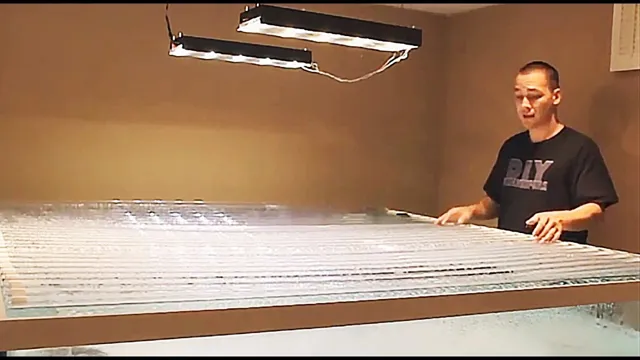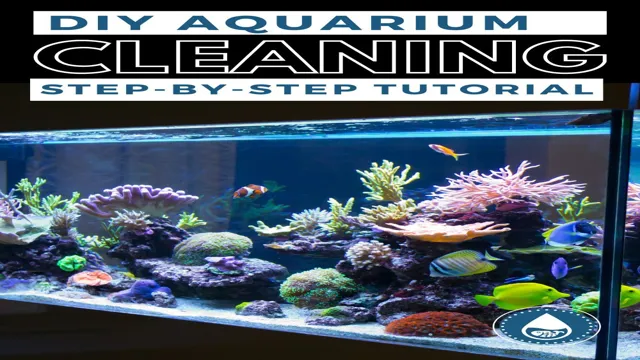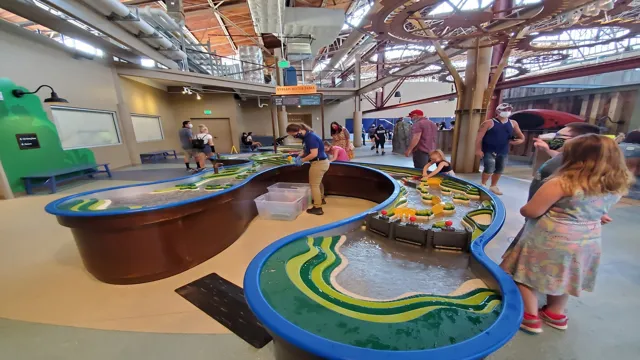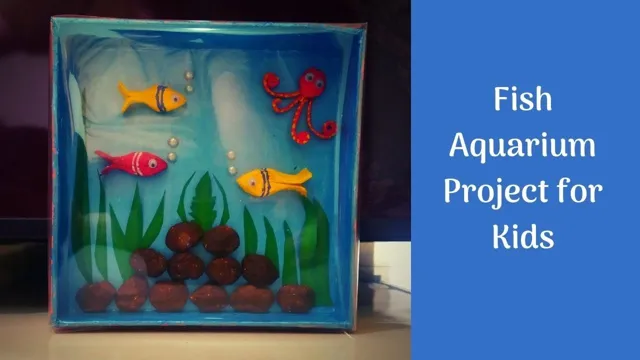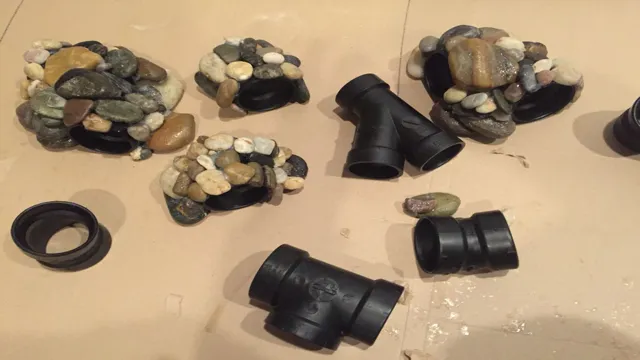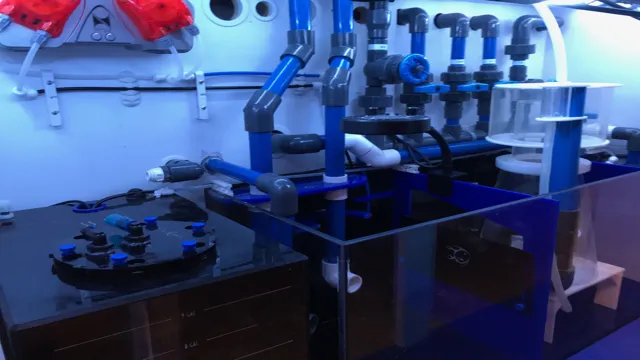Imagine having a lush green lawn growing right inside your aquarium! It’s possible to create a microcosm of nature that’s both pleasing to the eye and has added ecological benefits for your aquatic pets. Growing lawn grass in your aquarium not only creates a visually appealing aquascape, but it also improves the water quality by absorbing excess nutrients and harmful chemicals. There are several different types of lawn grass that can be used in aquariums, each requiring specific care and maintenance.
Some of the most popular types include dwarf hairgrass, glosso, and Monte Carlo. In order to promote healthy growth, it’s important to provide your aquarium grass with adequate lighting, proper water flow, and nutrient-rich substrate. Aside from improving the overall appearance and health of your aquarium, growing lawn grass can also offer many benefits to your aquatic pets.
Fish such as corydoras and bottom-dwelling species will appreciate the added cover and hiding spots, while snails and shrimp will have a natural food source to graze on. While growing lawn grass in your aquarium may require some additional effort and time, the end result is a beautiful and thriving aquatic environment for your pets. Let’s dive into the specifics of establishing and maintaining your very own aquascaped lawn!
Understanding the Requirements of Lawn Grass
If you want to grow lawn grass in your aquarium, you need to understand its requirements. Lawn grass needs plenty of sunlight to grow and flourish, so make sure your aquarium is placed in a spot that gets enough sunlight. You’ll also need to regularly fertilize your grass and keep the water pH level between
5 to It’s important to provide proper aeration and circulation of water to prevent the grass from becoming stagnant.
Selecting the right type of grass for your aquarium is also important as some varieties require less maintenance than others. By paying attention to these requirements and providing proper care, you can grow a lush and vibrant lawn grass in your aquarium.
Type of Lawn Grass Suitable for Aquatic Environment
If you’re looking for lawn grass suitable for an aquatic environment, you need to understand the requirements of the grass. Not all types of grass can withstand the constant flooding and excessive moisture usually found in areas surrounding water sources. When selecting lawn grass, you need to choose one that can tolerate waterlogging, high humidity, and low light intensity.
Bermuda, Centipede, and Zoysia grasses are the most popular species used in aquatic environments. Bermuda grass is drought-resistant and can tolerate moderate to heavy traffic, making it a great candidate for high foot traffic outdoor spaces subjected to frequent waterlogging. Centipede grass requires low maintenance and is shade tolerant, making it ideal for use in shaded aquatic environments.
Zoysia grass is renowned for its ability to resist disease and is tolerant of shade, making it perfect for aquatic environments subject to partial or complete shade. Whatever your choice, be sure to select a grass species that can thrive in your specific aquatic environment.
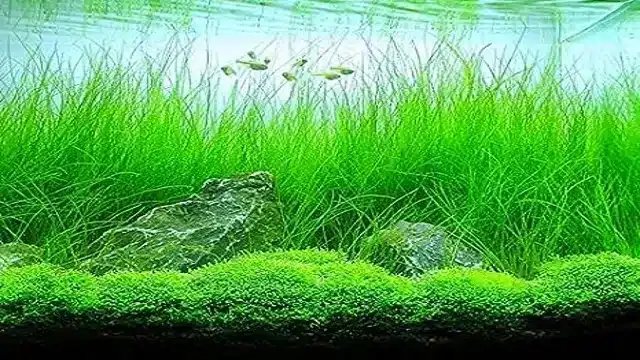
Essential Requirements to Grow Lawn Grass in Aquarium (Light, Water, Nutrients)
Growing lawn grass in a freshwater aquarium can be a great way to add some natural beauty to your aquatic environment. However, to ensure your lawn grass thrives, there are some key requirements you need to consider. Firstly, adequate light is essential for photosynthesis, which allows plants to grow and produce oxygen.
This means that your aquarium should have lighting that mimics natural sunlight, with a recommended 8-10 hours of light a day. Additionally, water quality is crucial for healthy plant growth; it should be clean with a pH level between 5 and
Proper water circulation is also vital, as it helps ensure that nutrients and oxygen are distributed throughout the aquarium. Finally, providing your lawn grass with adequate nutrients is essential, as these elements allow plants to grow and flourish.
You can use substrate fertilizers or liquid fertilizers to supply nutrients, as well as supplement with CO2 to promote plant growth. Overall, understanding the requirements of lawn grass is vital for planting and growing a lush and thriving aquarium garden.
Preparing the Aquarium
Growing lawn grass in an aquarium can create a beautiful eco-system for your fish to thrive in. Before setting up your lawn grass, it’s important to prepare your aquarium. First, clean all surfaces, including the substrate, plants, and decorations.
Then, add a layer of nutrient-rich soil to the bottom of your aquarium, followed by a layer of sand or gravel. Next, plant your lawn grass seeds evenly and add water until the soil is moist. Keep the aquarium in bright, indirect light between 70-75°F. (See Also: How to Distribute CO2 in Aquarium: Top Tips for Efficient Plant Growth)
After about two weeks, the grass should start to sprout, and you can add your fish to the aquarium. Make sure to trim the grass regularly to maintain a healthy ecosystem for your fish. With a little love and care, your aquarium can become a natural oasis for your aquatic friends, complete with a beautiful lawn grass floor.
Choose the Right Size Aquarium
When preparing an aquarium, choosing the right size is crucial. You want to make sure your fish have plenty of space to swim and thrive. One common misconception is that a smaller aquarium is easier to maintain and requires less work.
However, a smaller tank can actually be more difficult to maintain due to the limited water volume, making it more prone to fluctuations in water chemistry. On the other hand, a larger aquarium provides a more stable environment, making maintenance easier in the long run. Keep in mind that the size of your aquarium also depends on the type and number of fish you plan to keep.
A good rule of thumb is to allow one gallon of water per inch of fish. So if you plan on having a school of fish, a larger tank will be necessary. Ultimately, choosing the right size aquarium is a critical first step in providing a healthy and happy home for your aquatic pets.
Positioning the Aquarium for Adequate Lighting
When positioning an aquarium, it’s essential to consider the lighting requirements of the species you plan to keep. Before setting up your tank, conduct research to determine the proper lighting for your aquatic plants or animals. Some species require bright, direct light, while others may thrive in dimly lit environments.
Once you have a good understanding of your specific needs, consider the placement of your aquarium within your space. It’s best to avoid direct sunlight, as it can lead to overheating and algae growth. Instead, opt for an area with natural or artificial light that can be controlled.
As a rule of thumb, keep your aquarium out of high-traffic areas, as vibrations and movement can stress your aquatic life. By taking the time to research and plan your aquarium’s positioning, you’ll help ensure that your aquarium thrives and that your plants and animals remain healthy and happy.
Add a Substrate and Nutrient-Rich Soil
When it comes to setting up your aquarium, one of the most important steps is preparing the substrate and soil. This is where your plants will grow, so it’s crucial that you choose a nutrient-rich soil that provides the appropriate environment for them to thrive in. Before adding the soil, it’s important to thoroughly clean the bottom of your aquarium to remove any debris or impurities.
Once this is done, you can add a layer of substrate to the bottom of the tank, followed by a layer of nutrient-rich soil. This will help establish a healthy ecosystem in your aquarium and provide your plants with the essential nutrients they require to grow strong and healthy. Be sure to choose a soil that’s specifically designed for aquariums and avoid using any soil that contains chemicals or other harmful contaminants that could harm your fish or plants.
With the right substrate and soil in place, you can create a vibrant and thriving aquatic environment that will provide your fish and plants with the ideal conditions for growth.
Planting the Lawn Grass
If you want to grow lawn grass in your aquarium, there are a few important steps that you should follow. First, choose a grass variety that can survive and thrive in underwater conditions, such as hairgrass or dwarf sagittaria. Next, prepare the substrate by adding a layer of nutrient-rich soil or sand.
Spread the grass seeds or plant the grass plugs evenly across the substrate, covering the entire surface area of the aquarium. Ensure that the seeds or plugs are firmly pressed into the substrate, and that the water level is not too deep to submerge the newly planted grass. It is important to maintain consistent temperature and lighting conditions, and to provide regular fertilization and CO2 supplementation for optimal growth.
With patience and care, you can enjoy the beautiful sight of lush, green lawn grass swaying gently in your aquarium.
Sowing the Seeds or Planting Grass Shoots
Planting the lawn grass is an essential task to achieve and maintain a healthy and lush-looking lawn. Before seed planting, ensure that the soil is prepared correctly. Clear away any debris and remove any weeds, rocks, or roots that may obstruct growth. (See Also: How to Clean a Freshwater Fish Aquarium: A Step-by-Step Guide for Crystal Clear Water)
Then, loosen the soil with a tiller or rake to a depth of at least six inches, allowing the roots to spread easily. It’s advisable to take a soil test to determine its pH level, nutrients, and composition to know if additives are necessary. Next, pick the appropriate seed for your climate and grass type, depending on whether you want a practical, low-maintenance lawn or beautiful, attractive turf.
Spread the seed evenly according to the recommended application rate, and water the area generously, but do not soak the soil. Water regularly until the grass is well established, and keep the soil moist. With proper care and maintenance, your lawn grass will germinate, and you’ll have a property that looks fabulous for years on end!
Watering and Fertilizing the Grass
When it comes to planting lawn grass, it’s important to choose the right type of grass for your climate and soil conditions. Once you’ve selected your grass, it’s time to start planting. You’ll want to prepare the soil by removing any rocks or debris and tilling the soil to create a level surface.
After the soil is prepared, you can spread the grass seed or lay down sod. After planting, you’ll want to keep the soil moist by watering regularly. This is especially important during the first few weeks as the grass becomes established.
You can also help your grass grow strong roots by fertilizing every four to six weeks with a balanced fertilizer. By taking the time to properly plant and care for your lawn grass, you’ll be rewarded with a lush and beautiful lawn that you can enjoy all year round.
Maintenance and Care
Aquariums can be a great way to display eye-catching, aquatic scenes, but did you know that you can even grow lawn grass in one? Growing lawn grass in an aquarium is a unique way to add a touch of greenery to your tank, but there are some important steps to follow. First, choose a type of grass that can flourish in an aquatic environment, such as dwarf hairgrass or micro sword. Then, prepare the substrate, which is the material used to grow the grass, by thoroughly cleaning it and placing it in the aquarium.
Next, carefully plant the grass into the substrate and ensure it receives the right amount of light and nutrients to grow. Be sure to monitor the water quality closely and avoid overfeeding your fish, as excess food can harm the grass. With proper care and attention, you can keep your aquatic lawn looking lush and vibrant.
Trimming the Grass Regularly
Maintaining your lawn is crucial for keeping it healthy and looking beautiful all year round. One of the most basic, yet important, tasks you can do for your lawn is to trim the grass regularly. This not only helps to maintain the overall appearance of your lawn but also serves as a preventative measure against weeds and pests.
By trimming the grass, you can also ensure that your lawn receives adequate sunlight and water, which are essential for its growth. However, it’s important to remember that the frequency and height at which you mow your lawn can vary depending on the type of grass and the season. For instance, during the summer months, it’s best to mow at a higher height to help retain moisture in the soil and prevent it from drying out.
The key to maintaining a healthy lawn is to stay consistent with your maintenance routine and pay close attention to its needs. So, grab your lawn mower and get to work! Your lawn will thank you.
Checking and Maintaining the Water Quality
When it comes to maintaining a healthy swimming pool, checking and maintaining the water quality is a crucial step. It’s important to regularly monitor the pH levels, chlorine levels, and alkalinity of the water to prevent the growth of harmful bacteria and ensure a safe swimming experience. Additionally, one should clean the filters, skimmers, and pump baskets on a regular basis to keep the pool water clean and free of debris.
It’s also essential to regularly test the water and add chemicals if necessary, to ensure that the water remains balanced and clear. A healthy pool requires proper maintenance and care, but with the right tools and knowledge, it can be an enjoyable and safe place for all. So, have you checked the quality of your pool water today?
Managing Algae Growth
Algae growth is a common issue faced by pond owners and can often be a nuisance if not taken care of regularly. The key to managing algae growth is maintenance and care. The first step many pond owners take is to add an algaecide to the water, but this should not be the only approach. (See Also: How to Care for Aquarium Freshwater Lobsters: A Complete Guide to Proper Lobster Care)
Regular maintenance and care are essential and involve physically removing any visible algae from the pond water and ensuring that the water is well-aerated and well-circulated. A well-maintained pond will have a healthy ecosystem with beneficial bacteria, plants, and animals that help to control algae growth. It’s essential to keep an eye on the nutrients in the water, as an excess of nutrients from animal waste or plant debris can encourage excessive algae growth.
By providing proper care and keeping an eye on the pond’s balance, you can successfully control and manage algae growth, creating a beautiful and healthy environment for all your aquatic life.
Conclusion
Well, after all this information it may seem like growing lawn grass in an aquarium is quite a challenge. But fear not, with the right tools, patience and a little bit of creativity, you too can create a beautiful underwater garden that will impress all your aquatic friends. Just remember to consider the lighting and substrate needs of the grass you choose, and to maintain proper water conditions.
And who knows – maybe someday we’ll see aquarium-keeping clubs start holding lawn mower races!”
FAQs
Can I really grow lawn grass in my aquarium?
Yes, it is possible to grow lawn grass in your aquarium with the right conditions and care.
What type of grass is suitable for aquariums?
Carpeting grasses like Dwarf Hairgrass, Glossostigma, and Monte Carlo are preferred for aquariums.
What kind of lighting is required for growing grass in an aquarium?
High-intensity lighting with a color temperature between 5,000-7,000 kelvins is required for optimal growth.
What type of substrate is suitable for growing aquarium grass?
A nutrient-rich substrate like aquasoil or fluorite is recommended for growing aquarium grass.
How often should I fertilize my aquarium grass?
Weekly fertilization with a liquid aquarium fertilizer or root tabs is recommended for healthy growth.
Do I need to supplement CO2 for my aquarium grass?
Supplementing CO2 can enhance the growth of aquarium grass, but it is not necessary for basic growth.
How do I maintain my aquarium grass and prevent algae growth?
Regular trimming, proper lighting, and nutrient balance can help maintain aquarium grass while reducing algae growth.


